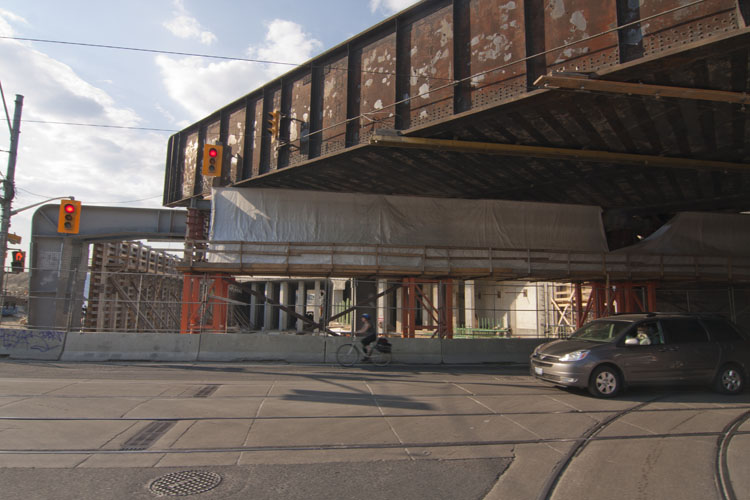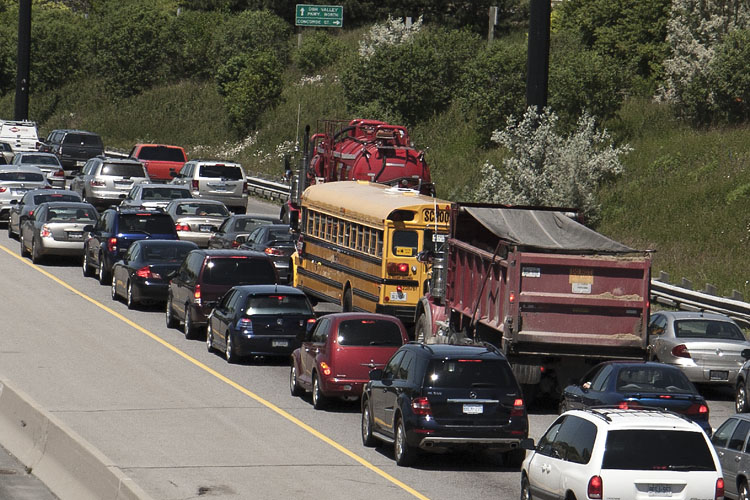 |
|
|
Information for DriversRecently, the media and politicians have polarized the debate on transportation in the Greater Toronto Area, framing improvements to public transit and active transportation as the “War on the car”46,66,85. The fact is that those of us who wish to see transit expansion are not necessarily advocating for drivers to all give up their cars. Cars lend themselves well to certain commutes that cannot be adequately served by transit, occupations that must carry a great deal of materials with them, and individuals with certain disabilities who may not be able to effectively use the transit system. Drivers must begin to understand that the solution to our region’s transportation problems is through transit, whether they choose to continue to use their own vehicles or not. The Greater Toronto Area has one of the longest commutes on the planet, and is expected to grow by another 1.85 million people by 2031, contributing even further to congestion69,72. 400,000 of those people will live in the City of Toronto itself, with 540,000 new jobs in the city. Given our current congestion problems, it is obvious that our current transportation infrastructure cannot accommodate these new residents. Road expansion in the Greater Toronto Area (GTA) is certainly a possibility for certain areas, and is already occurring. Southern Ontario is in the middle of a 5-year program to improve and expand highways at a total cost of $3.4 billion. Projects around the GTA include a widening of Highway 7 and Highway 400, a northern extension of Highway 410, a northern extension of Highway 404, and an eastern extension of Highway 407114. Within the boundaries of the City of Toronto, however, no new space for road expansion exists. Though minor improvements are being made such as the Dufferin and Simcoe underpasses to improve traffic flow, it has been stated that the City of Toronto will not be engaging in any new major road construction105. With the city entirely built up, there is no more room available for greater road capacity. Because there will be no new roads constructed, the only way to increase capacity of our roads is to convince more people to leave their car at home. While a certain percentage of these people can be moved to active transportation, such as walking or cycling, our winter climate prohibits many from using these modes of transportation. As of the last census, only 1% of work commutes were made by bicycle27. Though efforts have been made by the city to improve that figure, a recent cycling study shows that very few people are willing to bike in the winter, so that figure can only go up so much88. Politically speaking, it is also difficult to build bike lanes to encourage more bicycle usage when a lane of traffic is taken away to accommodate the new bike lanes123. Slightly under 5% of individuals walk to work, but that is only feasible for shorter distance commutes. What needs to happen is an expansion of the transit system, and a large one that will encourage a number of drivers to switch to transit, freeing up capacity on our clogged roads. Subway construction does not necessarily need to directly improve an individual’s commute to see the indirect benefits of it. They can either use the line directly, or benefit from a decrease in the number of commuters using the same mode of transport as they are11. A new subway has an ability to not just relieve crowding of the subway system, but also attract new riders that previously would not have considered transit as an option. This is due to a much faster trip to their destination, as well as a higher quality of service provided, as people have a significant preference of subway travel over their previous transit alternative, bus travel13,55. The practical capacity of a subway with the new Toronto Rocket trains on the TTC is approximately 33,000 per hour per direction172. For the sake of comparison, the Gardiner Expressway and Don Valley Parkway, each with three lanes per direction, can handle 6,000 vehicles per hour105. With the current GTA vehicle occupancy rate of 1.2 people during the peak period17, that means the Gardiner and DVP can each transport approximately 7,200 people per hour per direction. Based on ridership projections for the Downtown Relief Line, during peak hours, the line would attract enough new riders to the line who previously did not use transit to take the equivalent of 75% of the current level of traffic off the DVP southbound in the peak morning hour. Often, criticism comes from drivers in regards to the subsidies transit receives by the government in order to remain operational. The first thing that should be understood is Toronto has by far the most efficient and economical transit system in North America, recovering between 70-80% of its cost through the farebox. This is in stark contrast to most cities, which run at under 50%, meaning our subsidies are currently the lowest on the continent121. Even when our level of subsidy is not compared to other cities, investment in transit operations provides numerous benefits to the city, even to those who do not use transit. In fact, subsidizing transit can lead to increased monetary savings for drivers. A 2000 FTA paper entitled “Transit Benefits 2000 Working Papers: A Public Choice Policy Analysis” analyzed time savings created by new rail construction, and found that at a rate of $15/hour, $225 million per year was saved. In Toronto, that savings would be more in line with $345 million per year77. Moreover, they found that the $225 million savings break down to $65 million for transit users, $82 million to people driving within the same general travel corridor as the transit line, and $78 million to other drivers. Using the figures adjusted for Toronto, this would mean that drivers would save $245 million per year. This is a substantial savings, minimizing the net financial impact on citizens, especially for drivers168. The City of Toronto lists ten reasons why transit is subsidized; reasons which benefit the economy, the environment, social equality135. Those reasons are:
In addition to subjective benefits listed by Toronto in regards to subway subsidy, an objective analysis done by Christopher Kennedy in 2002 concluded that it make significant sense to subsidize public transit, noting that it costs the Greater Toronto Area three to six times more to transport residents using private automobiles than it does to transport them by using transit94. Therefore, a subsidy that convinces more people to use transit can actually save the region money. Kennedy goes on to quantify the environmental benefits, noting that public transit results in ten times fewer greenhouse gases emitted per person when compared with a private automobile. This project should therefore not be seen as a war on cars, but as a way to improve transportation, and subsequently, the health and the economy of everyone in the city. The benefits of construction will be seen to all, not merely a handful of transit riders. Though the initial cost of constructing the line may be high, the benefits seen by the citizens of Toronto far outweigh those costs. Image SourcesFrom top to bottom:
|

